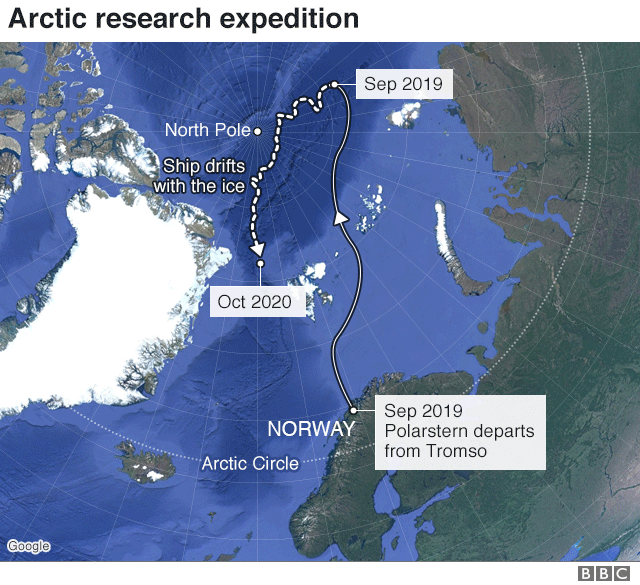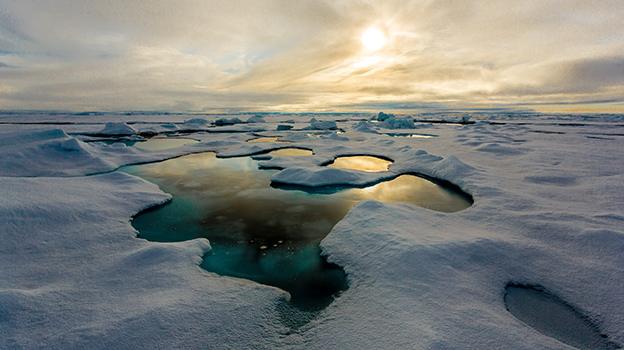Climate change: Polarstern leaves for 'biggest ever' Arctic expedition
- Published
Julienne Stroeve: "It will be brutal if the wind speeds get up"
The largest Arctic science expedition ever conceived is under way.
The German Research Vessel Polarstern left port late on Friday for the far north where it intends to lock itself in the sea-ice and drift for an entire year.
Hundreds of scientists will visit the ship in that time to use it as a base from which to study the climate.
A large crowd gathered at the quayside in Tromsø, Norway, to see the vessel off.
It is being accompanied on the first stage of its mission by the Russian icebreaker, the Akademik Federov.
The pair will head to the Siberian sector of the Arctic ocean to find the most suitable place in the floes for the Polarstern to begin its drift.
The MOSAiC, external (Multidisciplinary drifting Observatory for the Study of Arctic Climate) project is expected to cost about €130m (£120m/$150m).
Its scale means it must be an international effort. RV Polarstern will also be supported by icebreakers from Sweden and China.
In deep winter, when these vessels can't pierce the ice to reach the German ship, aeroplanes and long-range helicopters will deliver the supplies and relief teams.
Allow X content?
This article contains content provided by X. We ask for your permission before anything is loaded, as they may be using cookies and other technologies. You may want to read X’s cookie policy, external and privacy policy, external before accepting. To view this content choose ‘accept and continue’.

MOSAiC's objective is to study all aspects of the climate system in the Arctic. Instrument stations will be set up on the ice around the Polarstern, some of them up to 50km away.
The ice, the ocean, the atmosphere, even the wildlife - all will be sampled. The year-long investigations are designed to give more certainty to the projections of future change.
Prof Markus Rex from Germany's Alfred Wegener Institute in Potsdam is the expedition leader. He said the Arctic was currently warming at twice the rate of the rest of the planet but that the climate models were highly uncertain as to how the temperature trends would develop in the coming decades.
"We don't have any robust climate predictions for the Arctic and the reason is we don't understand the processes there very well," he explained.
"That's because we were never able to observe them year round and certainly not in winter when the ice is at its thickest and we can't break it with our research vessels," he told BBC News.


Markus Rex: "We're going to build a small research city around Polarstern"
Embedding in the sea-ice will be done close to 85 degrees North and 130 degrees East.
Precise positioning will be important. Modelling of the winds and currents suggests the ship should drift across the top of the planet, getting to within a couple of hundred km from the North Pole, before then being ejected from the frozen floes between northeast Greenland and Svalbard - the Fram Strait.
But there is a critical point in this 2,500km journey where, if the ship meanders too far to the west, it could get pulled into the Beaufort Gyre - the great clockwise movement of water and ice in the Arctic. Once caught in this gyre, it would need a huge effort to escape.
Something similar to MOSAiC has been tried before.
The expedition has definite echoes of the Norwegian explorer Fridtjof Nansen's attempt in the 1890s to be the first person to reach the North Pole by drifting in a ship locked in ice.
The Canadian Coast Guard vessel Des Groseilliers, external mounted a drift mission in the late 1990s which became known as Ice Station SHEBA.
The Norwegian Polar Institute's Lance vessel undertook a drift expedition in 2015; as did the scientific schooner Tara, external, which traversed the frozen ocean - again, from Siberian waters to the Fram Strait - in 2006/7.
But none of these previous ventures can be compared to the German mission for size and international input.

The Arctic is warming at twice the rate of the planet as a whole
The conditions faced by the scientists over the coming months will be harsh.
For half the year the Sun will not rise above the horizon and temperatures will dip down to minus 45C.
And the teams working on the ice will have to be on constant alert for predatory bears.
"Various scientists have been trained on using night-vision goggles to stand guard for polar bears," said Prof Julienne Stroeve from University College London (UCL).
"You can't ever go out on the ice without someone being there with a rifle. [The bears] could eventually smell the ship and if they get curious enough they'll come and check us out."
Prof Stroeve is in the seven participating teams from the UK.
She will join the Polarstern in mid-winter. Her experiments will assess the accuracy of the radar satellites that are used to map the thickness of the sea-ice from orbit.
These spacecraft work by bouncing a microwave pulse off the floes, but there is some uncertainty over where exactly this reflection occurs in a column of snow and ice.
If the UCL scientist's suspicions are confirmed during the MOSAiC cruise, it would have implications for our current assessment of the status of Arctic sea-ice.
"It would be thinner than what we've been estimating so far," she told the BBC's Inside Science programme.